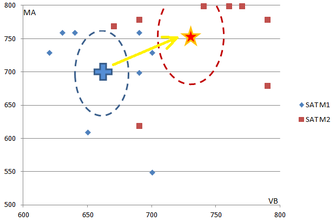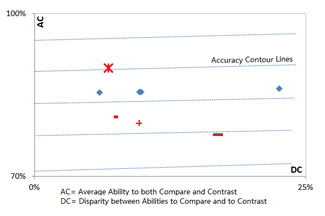|
As we just completed a 5-day camp in Chicago, it makes sense to summarize what I observed among these eight students from south and west of Chicago suburban schools. Let me start with the chart. Overall, the students reached a growth of 150 score points on their SAT levels, of which 100 counts towards verbal and 50 on math. These gains rank similar to the gains among the students in the weekly camps earlier this year, around Chinese New Year. While almost every one realized stunning gains, two students attracted much of my attention, Caro and Ale. They both belong to the high level subgroup of four who had already made themselves 690-700 in verbal. A mid level subgroup consists of another four students with 620-660 in verbal. Caro and Ale did not move up in verbal as their peers during the five days. What caused it? To find it out, we have to graph a different chart. The dominant factor describes the your average ability to think both comparatively and contrastively. Compare and contrast as two and only fundamental elements of critical thinking. Not only that your neurons are designed to perform these two jobs, these abilities on complicated objects are built as you are trained throughout the years. Most of times you just need this average factor to tell how well we can do in school subjects. Same is true in any tests.
Taking it to the standard test, there is a second factor that contributes to your overall accuracy. It is the difference between your two abilities. The bigger the disparity, the lower the overall accuracy. When you are better in comparing than in contrasting (or the other way around), your overall accuracy is driven down. Taking two factors into account, you generally want high and balanced levels of comparative and contrastive thinking. Looking at Caro and Ale, I found exactly the same pattern of their comparing v.s. contrasting abilities. Both maintain excellent levels of either compare or contrast, while both have the other ability as non-desirable. As a result, their overall accuracy is dragged. Comparing and contrasting are drivers to your learning curve. When you learn new things, the first ability you call on is comparing. Being able to tell similarity between the new information and existing ones means understanding. When you fully comprehend, the next thing you do is experimenting with it. This takes more or less the braveness or risk-averse in reality. Nothing can be learnt but never tried. To try is to familiarize you with the differences that come with it. In this step, you start with contrast, and ends with comparison that embraces the newly experienced differences. It is by both comparing and contrasting that we eventually learn anything. If you are one who shines at your school but is stranded by standard tests, you are likely having the same problem as Caro and Ale. Abilities to compare and contrast often go against each other when either one is overwhelmingly trained or used. Nowadays in school, the ability to compare is often the one you are mostly good at. Being able to contrast effectively is likely what you need leading to your next test.
0 Comments
Your comment will be posted after it is approved.
Leave a Reply. |
The F‘LOGsthink, teach and enjoy Archives
November 2023
Categories |



 RSS Feed
RSS Feed
